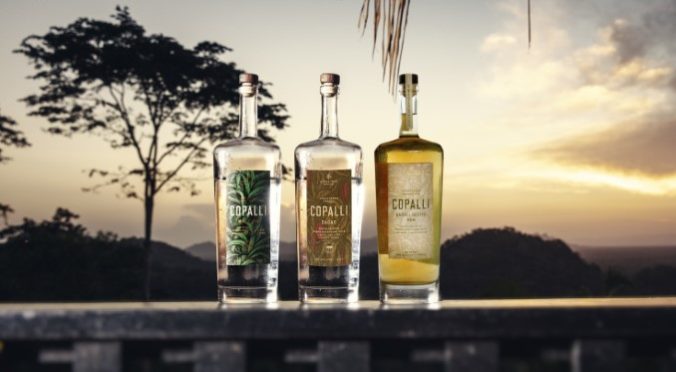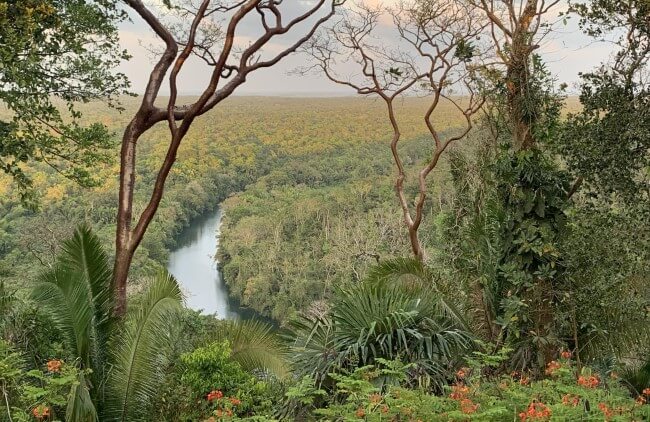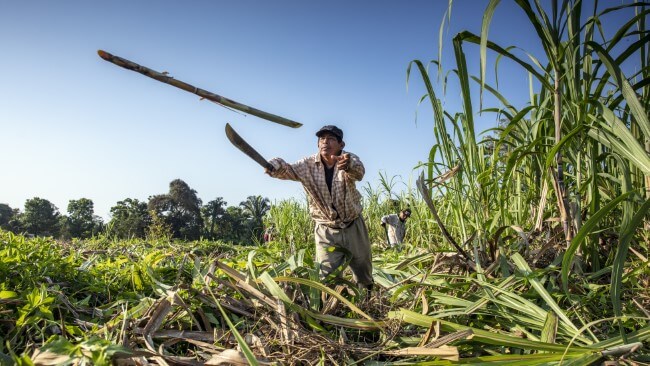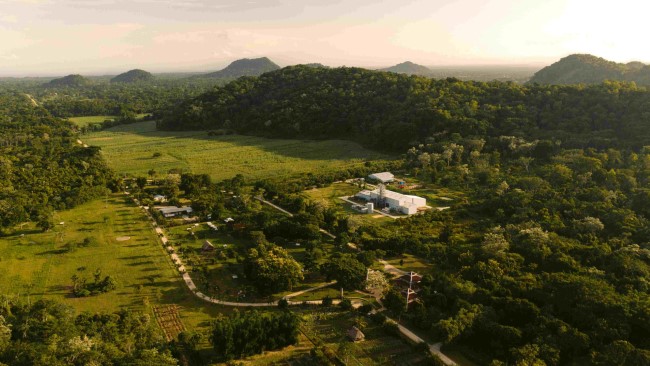Copalli Rum: A Spirit at Harmony with the Belizean Rainforest

If you had asked me to describe the sound of a howler monkey before spending the first night at southern Belize’s Copal Tree Lodge, I’m not sure how exactly I might have replied, but any guess I made then would have proven comically incorrect. Most likely, I would have imagined the screeching of a chimpanzee, some stock sound effect ready to be queued up in the jungle scene of a Hollywood adventure film. What I would not have described is a guttural moan that sounds something less than organic at times, like raspy pieces of sheet metal being scraped together, high in the canopy above your cabin. Hearing that sound in the dead of night, it makes perfect sense when you read that the voices of these howler monkeys were ultimately used as dinosaur sound effects throughout the Jurassic Park franchise–they have an unearthly quality to them that reinforces the sense of place: You are camped on the edge of true wilderness.
And yet, there’s also a beautiful swimming pool. And a delicious farm to table restaurant. And one of the greenest and most environmentally friendly distilling operations I’ve ever come across anywhere. Such is the duality of the lodge and the Copal Tree Distillery, a rum-making operation built from the ground up to truly work in harmony with the rainforest that surrounds it on all sides. Every part of the resort and distillery’s mission ultimately comes back to this focus on honoring the sanctity of the little patch of Belize they call home. It’s what makes Copalli Rum so very distinctive.
A Sanctuary in the Rainforest
The Copal Tree Lodge began its life as a destination lodge for fly fishermen, who traveled from far and wide to drop a line in the neighboring Rio Grande River, which snakes placidly through the rainforest to the sea, gradually changing from lush forest to brackish mangrove swamp as it nears the ocean. The lodge has changed hands and identities a few times since, but the fishermen remain, now joined by an assortment of honeymooners, families and romantics looking to embrace a tropical sense of adventure in what is now a luxurious resort perched on a hill, overlooking stunning rainforest vistas. Blissfully situated in a breezy corridor, the lodge feels like a true oasis of comfort surrounded by the more oppressive heat and humidity of the jungle that envelops it. For travelers, it’s momentarily easy to forget exactly how far you’ve traveled to be in this serene place … until you hear those howler monkeys, or the calls of roving, colorful toucan or trogon in the canopy.

When you can get a shot like this from the grounds, on a phone camera, then you know you’re in a beautiful place.
Following a breakfast of eggs, beans and “fry jacks”–a Belizean comfort staple of fried bread dough, which puffs up and opens a pocket for dipping in beans or jam–a visitor might decide to arrange a guided tour of Copal Tree’s 3,000-acre sustainable farm, which provides fresh produce for the on-site restaurant. Here, one can learn a great deal about the various herbs, flowers, grasses, shrubs and tropical weeds that are cultivated on the grounds, many of which have for centuries been used for medicinal purposes by the area’s earliest residents. Today, many of these plants are still cultivated for their pharmaceutical effects, prized by Belize’s diverse peoples–Mayan descendents, Belizean Creoles, East Indian Belizeans, Garifuna people and many more. One will also see cacao and coffee beans undergoing natural sun-drying and fermentation, and visitors can ultimately trace these processes all the way to their conclusion by producing small batches of chocolate or coffee at the farm’s adjacent roastery. Trust me when I say that there are few aromas better than freshly roasted cacao nibs, or a just-shaped block of cocoa butter.
The lodge’s sustainability mission has even managed to positively impact its surrounding Belizean community in Forest Home village and the neighboring town of Punta Gorda, where visitors are likely to arrive via prop-driven plane. In recent years, the Copal Tree Lodge has successfully managed the delicate task of reaching out to local residents and dissuading them from exploitative work such as illegal logging or trapping in the neighboring 12,000 acres of rainforest preserve, often by offering work directly on the lodge itself. Thus, a person who was previously making their living via illegal fishing or cutting down trees may have a chance to substitute experience in sustainable sugarcane or cacao farming. One local illegal logger, in fact, was eventually talked into joining the Copal Tree Lodge team, where he took an interest in chocolate making, eventually receiving training in the U.S. before becoming the lodge’s head chocolatier. Today, the former logger serves as the head of maintenance for the entire facility, overseeing the energy efficiency efforts of the resort.
But where the symbiosis between nature and artistic creation really shines the most at Copal Tree is in its distillery, and the Copalli Rum that captures the distilled terroir of Belize itself.
A Symphony in Sugarcane

The Copal Tree Distillery is located on the same grounds as the lodge, away from the airy hillside and closer to the sun-drenched farm, nearer to the crop that literally fuels its daily operations: The sugarcane fields.
Sugarcane is a fascinating plant, and a hardy one, that most Americans know relatively little about. It’s the source of our common table sugar, but also the reason for the existence of molasses, a byproduct of crystal sugar refinement that enterprising distillers realized hundreds of years ago could be fermented and then distilled into rum. Today, the vast majority of rum on Earth is made from molasses, in famous rum-producing regions such as Barbados, Jamaica or Puerto Rico. But that’s not how they do things at the Copal Tree Distillery, because sugarcane isn’t being processed into crystal sugar at this site at all. Rather, it’s being squeezed for its sweet, sugar-rich juice.
This is a decidedly different, more verdant method of rum production, to ferment and then distill fresh sugarcane juice in a mode similar to the rhum agricole of a Caribbean island like Martinique. The resulting rums produced in this method–especially via pot still–have a tendency to more strongly reflect the natural flavors and botanical nature of the sugarcane itself, delicate grassy, herbal or fruity flavors that are lost in the transition to molasses. A rum made in this way tends to preserve a greater sense of the fields it came from, a quality you might know as terroir. All Copalli Rum is made this way, although it’s still not so simple as just growing and harvesting sugarcane on the Copal Tree Lodge territory.
There are many varieties of sugarcane, you see, and Copalli Rum is making use of more than one. Scan the fields, and you can see the difference yourself between the maroon-tinged red sugarcane and the deep, inky purple black sugarcane. Slash a stalk down with the closest machete, peel back the skin and you can taste the juice by simply chewing the fresh sugarcane flesh, and the two species prove remarkably distinctive. The red cane has melon-like flavors, with subtle tropical fruit and floral notes, while the black cane is notably juicier, sweeter and more intense, bringing out vanilla and an almost roasted, caramelized fruitiness. Unsurprisingly, these flavors transfer throughout the production process into finished rums, yielding significantly different profiles when different cane species are used. One can even get an idea of how the cane juice might taste after fermentation simply by finding cane that has been cut and resting on the ground, where it naturally ferments, becoming increasingly tangy and funky in the process.

During the production season, the distillery will crush 50 tons of sugar cane in a day.
As one might expect, the lodge’s insistence upon sustainability also comes into play in a big way in the production of rum, all of which reduces the distillery’s carbon footprint as much as it can possibly be reduced. For starters, unlike many sugarcane growers, Copalli Rum doesn’t burn its sugarcane fields before harvest, a practice that is thought to increase the amount of fermentable sugar in each stalk. In addition to reducing air pollution, this also allows the distillery to use the bagasse–the dry, pulpy fibrous material left over after smashing and pressing the juice out of the cane–as biofuel to power the stills themselves, while the nutrient-rich ash produced by the boilers is then returned to the sugarcane fields as fertilizer. Collected rainwater is used for the proofing of the rum, while wastewater from the distillery is first filtered and then sent to small retention ponds, where it is then used to water plants and crops on the farm. The entire process effectively results in almost zero waste products, as nearly everything can be reused to fuel the next cycle of growing and harvesting. This is what Copalli Rum means, when they talk about “sustainable” farming and distilling.

The distillery and farm, nestled into the Belizean rainforest.
Of course, the often intense tropical climate of Belize offers its own challenges for rum production, especially on the aging side of the equation. Rum geeks would know that aging in tropical environments tends to vastly accelerate the process with which the spirit interacts with casks (reused American whiskey barrels), as the intense heat and humidity helps to draw the liquid inside the barrels into and out of the wood. It also speeds up the process of evaporation, the percentage of liquid lost from each barrel on a yearly basis that is known as the “angel’s share.” Whereas the cool climate of a whisky region like Scotland might result in 3-4% evaporation on a yearly basis, and the hotter summers of Kentucky might yield 6% for major bourbon producers, Copalli’s barrels are losing a ridiculous 9% of their volume of liquid every year. Suffice to say, these are some thirsty, positively greedy angels.
That level of interaction with the wood, however, also means that Copalli’s spirit gains significant maturity in only months or a couple years, comparable to a spirit aged in Continental Europe for a far longer period. Tasting some extra-matured spirit that has spent around five years in the oak in Belize is a truly heady experience, yielding an incredibly dark mahogany tone and sweet flavors reminiscent of 15-year-old, deeply oaky bourbons that would be highly sought after in the modern whiskey hype cycle. When Copalli finally gets around to releasing liquid with this kind of maturity, they will likely see a sudden surge of interest from the dedicated rum collectors of the world.
When surrounded by a natural environment as lush and full of resources as the one that envelops the Copal Tree Lodge, it would be easy to simply exploit those valuable resources without consideration of the future. There’s no reason that the distillery legally has to produce rum in this way–they do it as part of an ethos that is built around preserving the natural beauty, biodiversity and sustainability of their home, so future generations can enjoy the same incredible access to the magic of the rainforest. Decades from now, one will still hopefully hear the unearthly calls of the howler monkeys reverberating in the canopy above the lodge–and you’ll still hopefully be able to do so with a daiquiri in hand.
Jim Vorel is a Paste staff writer and resident beer and liquor geek. You can follow him on Twitter for more drink writing.







































